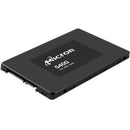Description
The Micron 5400 PRO SATA SSD is purpose-built for data centers that demand reliable, high-throughput storage with long-term endurance. With a capacity of 3.84 TB, this 2.5-inch drive fits neatly into standard enterprise servers, backplanes, and storage arrays, enabling scalable deployments without major infrastructure changes. Built on Micron’s proven SATA architecture and powered by 176-layer 3D NAND, the 5400 PRO combines dense storage with dependable performance. It is specifically optimized for read-intensive workloads, delivering fast, consistent read performance, low latency, and steady throughput across sustained operation. Whether you’re accelerating database caching, powering virtualized environments, or delivering content at scale, the 5400 PRO helps keep data flowing quickly while maintaining energy efficiency and reliability in demanding data-center conditions.
- 176-layer Micron 3D NAND technology enables higher data density and improved read performance, supporting larger caches and faster data retrieval while enhancing error resilience and data integrity in read-heavy workloads. This architecture also contributes to better energy efficiency, helping cooler operation and lower total cost of ownership in dense server racks.
- 2.5-inch internal form factor paired with a SATA III (SATA/600) interface ensures straightforward deployment into existing enterprise servers, storage arrays, and backplanes. This compatibility enables rapid upgrades, easier maintenance, and seamless integration with standard cabling and drive bays without requiring a complete hardware refresh.
- Specifically optimized for read-intensive workloads, the Micron 5400 PRO delivers fast random reads, low latency, and consistent throughput—ideal for caching layers, metadata services, content delivery, and analytics lookups where read performance directly influences application responsiveness.
- Energy efficiency and thermal stability are prioritized to maximize data-center utilization. The drive’s design emphasizes low active power during heavy read activity and steady thermal performance, helping to maintain reliable operation in multi-drive environments and reducing cooling load in large deployments.
- Designed for enterprise reliability, the Micron 5400 PRO incorporates data integrity features and robust mean-time-between-failure characteristics intended for long-term operation in data centers, ensuring predictable performance, durable endurance under sustained reads, and strong support for mission-critical storage infrastructures.
Technical Details of Micron 5400 PRO 3.84 TB Solid State Drive - 2.5" Internal
- Capacity: 3.84 TB
- Form factor: 2.5" internal drive
- Interface: SATA III (SATA/600)
- NAND technology: 176-layer 3D NAND
- Workload type: Read-intensive data center SSD designed for steady throughput and low latency
- Reliability: Engineered for long-term operation in enterprise environments with robust data integrity features
How to Install Micron 5400 PRO
Installing the Micron 5400 PRO in compatible servers, storage arrays, or backplanes is a straightforward process designed to minimize downtime and maximize compatibility. Before installation, verify that your chassis supports a 2.5" SATA drive and that you have the appropriate drive bay and backplane connections. Power down the host system and unplug all power and data cables to prevent any electrical or static discharge. If you are replacing an existing drive, carefully remove the old drive from its bay, noting its orientation and mounting screws for reuse. Prepare the Micron 5400 PRO by verifying the connector alignment and ensuring the mounting holes align with the drive tray. Slide the drive into the 2.5" bay or hot-swap backplane, and secure it with the appropriate screws or locking mechanism. Connect the SATA data cable to the drive and connect the SATA power cable to the drive from the server’s power supply or backplane. If your system uses a hot-swap tray, ensure the drive is fully seated and the tray is properly latched. Reconnect all cables, power up the system, and enter the storage controller interface or operating system to initialize the new drive. Depending on your environment, you may need to create a new RAID array, initialize the disk, partition it according to your storage strategy, and format it with the desired file system. After installation, run health checks and SMART monitoring to confirm healthy operation, verify firmware is up to date, and monitor performance to ensure the drive meets your expected read throughput and latency targets. Regular firmware updates and vendor-provided management tools can help maintain peak performance and reliability over the drive’s lifetime.
Frequently asked questions
- Q: What workloads is the Micron 5400 PRO best suited for? A: It is designed for read-intensive data center workloads, including caching, content delivery, metadata services, and quick data lookups, where fast, predictable reads and low latency are critical. The drive provides steady performance under sustained reads, making it ideal for environments that rely on rapid data access rather than heavy random writes.
- Q: What is the form factor and interface? A: The drive uses a 2.5-inch internal form factor with a SATA III (SATA/600) interface, ensuring compatibility with most enterprise servers, storage arrays, and backplanes that support 2.5" SATA drives.
- Q: Is this drive suitable for data-center deployments? A: Yes. It is engineered for enterprise reliability and long-term operation in data centers, with features designed to sustain data integrity, consistent performance, and energy-efficient operation across demanding workloads.
- Q: Do I need special drivers? A: Typically, no special drivers are required beyond standard SATA controller support. Some RAID controllers may require firmware updates or vendor-specific management tools; consult your hardware provider for compatibility and best practices.
- Q: How do I maximize performance with the Micron 5400 PRO? A: Ensure the drive is connected to a compatible SATA controller with current firmware, configure your OS or RAID controller for optimal read caching, align partitions properly, and monitor health metrics and SMART data to maintain consistent read performance over time.
Customer reviews
Showing - Of Reviews


